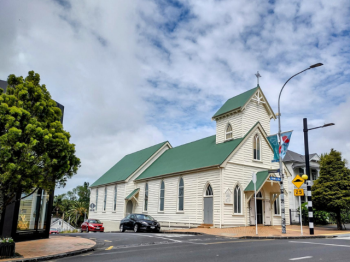Patronal Church of the Order in New Zealand
 Bishop Pompallier, the first Bishop of Auckland, member of the Order of the Holy Sepulchre, inaugurated and blessed the church of St. John the Baptist in Parnell, a central area of the city, which has become the Order’s patronal church in New Zealand.
Bishop Pompallier, the first Bishop of Auckland, member of the Order of the Holy Sepulchre, inaugurated and blessed the church of St. John the Baptist in Parnell, a central area of the city, which has become the Order’s patronal church in New Zealand.
After the signing of the Treaty of Waitangi in 1840, Apihai Te Kawau a chief of Ngati Whatua offered three thousand acres of tribal land to the British Crown. The church at Parnell is now sited on a part of that land, which was later purchased by an Anglican missionary, who in June 1858, sold it to Jean-Baptiste Pompallier, first Bishop of Auckland, to be used for religious and educational purposes. Shortly after purchasing the land, Pompallier became the Bishop of Auckland and established the church. It was named in honour of the Bishop Pompallier’s patron saint, Saint John the Baptist.
The church, initially a small timber building with a tower and spire, was opened and blessed on 12 May 1861 by Bishop Pompallier. It took its current form when it was enlarged with the addition of the extended East end in 1899. The sanctuary was reordered in 1931 with a design that largely remains to this day. Franciscan and Marist communities administered the Parish of Parnell until 1989 when the parish reverted to diocesan status. In 1997 the church was completely refurbished.
Saint John the Baptist Church at Parnell, Auckland, in a decree dated January 1, 2012, was named by the Prior of the Order, Bishop Patrick Dunn, KC*HS, Bishop of Auckland as the Patronal Church of the Equestrian Order of the Holy Sepulchre of New Zealand. The church was chosen because Bishop Pompallier, the first bishop of Auckland, was a member of the Order and he blessed the original church. It was also chosen because it was quite central to the city.
Saint John the Baptist Church, Parnell is listed as a heritage building and, as such, we continue to recognise and protect the church’s cultural heritage and character
(December 2022)



